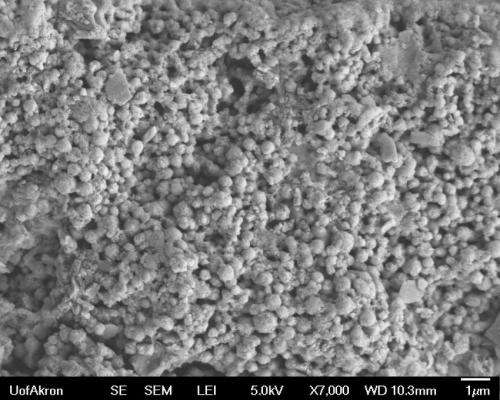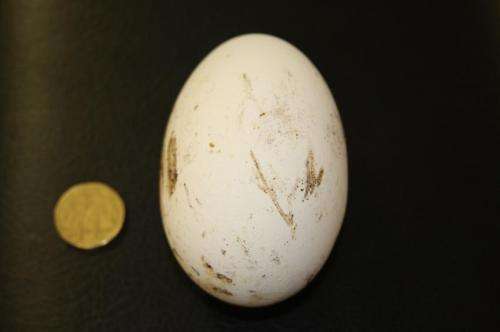Australian brush-turkey eggs inspire ideas for germ-resistant coatings

(Phys.org) —Rather than sit on its eggs to incubate them, the Australian brush-turkey buries them in rotting vegetation. While bacterial decomposition heats the eggs, it doesn't infect them. University of Akron scientists probed the phenomenon and discovered that the brush-turkey's eggshell surface—dotted with nanospheres—blocks bacteria. The finding, featured as the cover article in the April 2014 Journal of Experimental Biology, inspires possibilities for synthetic coatings that mimic the eggshell's germ-resistant properties.
"The eggshell is not like any other we have seen before. It looks like a tiny asteroid field," says UA visiting assistant professor Liliana D'Alba, describing what she and her research colleagues discovered when they examined the eggshell surface with a scanning electron microscope.
After testing the brush-turkey egg white, an important line of defense against infections, the scientists found its antimicrobial function to be no more exceptional than that of other bird eggs. They then examined the brush-turkey eggshell to find out if the nanoparticles shielded bacteria. Since water provides a breeding ground for bacteria, the researchers applied water to the eggshell to determine its hydrophobicity, or water repellency. Like water on a freshly polished car, water on the brush-turkey egg beaded up.
"Most bacteria grow best when water is available, and these eggs appear to reduce water on their surface," D'Alba says, noting that conversely, water spreads across the shell surface of eggs without nanospheres, such as chicken eggs.

The compelling finding provided indirect evidence of the eggshell's suspected antimicrobial properties and impelled the scientists to further examine the brush-turkey eggs and compare them to chicken eggs.
"The true test came when we directly measured how well bacteria stuck to the surface of the egg and, critically, penetrated through it to the egg contents," says Matthew Shawkey, associate professor of biology and integrated bioscience. "In both cases, brush-turkey eggs well outperformed chicken eggs.
The eggs' rough surface could serve double-duty, preventing bacteria from infecting the eggs by both limiting water and averting bacteria, according to the researchers. The eggshells' robust surface provokes ideas for developing a mimic synthetic coating to benefit medical, food processing, and manufacturing industries, to name just a few, the scientists say.
"Microorganisms grow anywhere. The potential application of a coating inspired by the surface structure of the brush-turkey egg is very wide," D'Alba says. "It could be of great benefit and applicable to any instrument or working area in contact with water."
More information: jeb.biologists.org/content/217/7/1116.full
Journal information: Journal of Experimental Biology
Provided by University of Akron




















